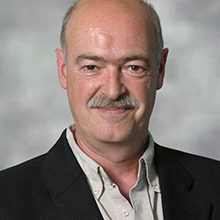Professor Martin Ryan wins the 2017 Unilever Colworth Prize
05 April 2017

Today at the Microbiology Society’s Annual Conference 2017, Professor Martin Ryan from the University of St Andrews will be awarded the 2017 Colworth Prize, sponsored by Unilever Research’s Colworth Laboratory. Martin has been awarded the prize in recognition for his work on picornoviruses that has opened up numerous translational opportunities in the field of biotechnology. You can see his lecture at 17:40 in the Pentland Suite, Level 3.
When did you realise that you wanted to follow a career in science?
Probably while I was doing my PhD with Jeff Almond at the University of Leicester. It was the early 1980s, and virology was really coming alive with new technologies – it was a massively exciting time. Early on, I realised that this was something that intellectually appealed to me and was going places.
What were you working on at the time?
At the time, Jeff was sequencing poliovirus – both naturally occurring and vaccine strains. I was working on a virus that appeared in the late 1960s called Enterovirus type 70, which caused a disease clinically indistinguishable to polio. The idea was to sequence that and see how related it was to polio.
How was the field of virology at the time?
It was the birth of a new era of virology – a huge amount of classical virology had been done, but really there was little information available on genome sequences. I was very fortunate to be there at the birth of this era, relating phenotypes to genome sequences, and of course a decade or so later the advent of reverse genetics made the field explode.
So this was the first time you could relate structure to function?
You got the exquisite mapping that mutations had on structures. At the time it was all structural proteins – since then we’ve got structures of proteases and polymerases as well.
You’ve changed discipline a few times, could you tell us about that?
My first degree was in Plant Biochemistry, then I went to Birkbeck to study for a master's degree in Microbiology. Plant molecular biology was also going through a transformation at the time, and I went to the University of Warwick to work on the biogenesis of pea chloroplast ribosomes, which wasn’t a million miles away from my first degree. Ultimately, I realised I was more interested in viruses and was lucky enough to be able to move back to virology at The Pirbright Institute.
You’re at the University of St Andrews now – what are you working on?
I’m working on the foot-and-mouth disease virus (FMDV), and we’ve been developing something we call the FMDV replicon, which is a form of the virus’s genome that has the capsid proteins replaced with fluorescent markers. These are completely biosecure and are part of a wider collaboration to develop new methods to control FMDV.
People are aware of the FMDV outbreak in the UK in the 2001. How is your work helping to prevent it happening again?
There’re still real problems with vaccinations in low- and middle-income countries, particularly relating to cost-per-dose. In higher-income countries we control the disease by mass slaughter or emergency vaccination. For economic and social reasons those aren’t transposable to many nations.
We’re trying to develop a new generation of live attenuated vaccines – the technology we’ve helped develop will allow us to make a vaccine backbone into which we could rapidly insert capsid proteins for any emergent strain to help rapidly respond to any threat.
What difference would a rapid response make?
Firstly, you get a much better immune response from a live attenuated vaccine, and you can envision a virtuous circle, where one vaccinated animal could pass the vaccine strain onto another animal, making seroconversion rates higher in areas where veterinary infrastructure is limited.
What does winning this prize mean to you?
It’s gratifying, because all the work that people have done in my lab throughout the years has been recognised. We know the work is valuable via citation numbers, but it’s a thrill for me personally because it shows the contribution is well regarded by others.
What advice would you offer to any early career researchers?
I would say that you have to have faith in what you’re doing, enjoy what it is and just keep plugging away. I’ve been in the fortunate position to enjoy the science I’ve done and that’s what keeps you going when your ligations don’t work!
Image: Martin Ryan.


